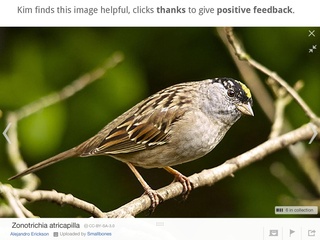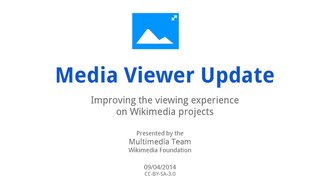Lesen/Multimedia/Medienbetrachter

Das ist die zentrale Projektseite für Media Viewer, ein neues Tool, das vom Multimedia Team der Wikimedia Foundation entwickelt wird. Um einen schnellen Überblick über das Projekt zu bekommen, besuche die Seite 'About Media Viewer'.
Media Viewer aims to improve the viewing experience for readers and casual editors on Wikipedia and Wikimedia sites.
Dieser neue Multimediabrowser stellt Bilder größer dar, mit nützlichen Informationen über deren Inhalt, Autoren und zugehörige Metadaten. Er bietet außerdem etliche Zusatzfunktionen zum vergrößern, teilen, downloaden oder einbinden der Mediendateien an, wie unten beschrieben wird.
Media Viewer was tested extensively during development, through usability studies, community consultations and online surveys. Based on this user feedback, the multimedia team developed a set of new improvements, to make Media Viewer easier to use by readers and casual editors, the primary target users for this tool.
Lessons learned from the development and from observing Media Viewer in production are available in the form of a retrospective and a research report.
Learn more about Media Viewer on this help page. Feedback is welcome in this discussion.
Ziele

Zweck
Das Ziel des Medienbetrachters ist:
- improve the viewing experience for readers and casual editors
- make it easier to preview and browse images
- provide a quick summary, with easy access to details
- offer more features such as enlarge, download, share and embed
These features are expected to encourage casual users to contribute more to Wikipedia and Wikimedia sister projects over time.
Benutzer
Primary users for Media Viewer are:
- readers
- casual editors
Andere Benutzergruppen:
- experienced editors
- contributors
Geschichten teilen
We aim to support all these user groups, with an initial focus on readers in our first release. See user stories below for each user group.
Geschichten teilen
As a reader, I want to:
- view larger images
- find basic information
- browse related images
- share a link to this file
- use a simple, uncluttered interface
- view images on the same page (not another site)
- get back to the article easily
Casual editor stories
As a casual editor, I want to:
- find more information
- see original images
- use this file in an article
- download this file
- view license terms
- view/edit file page details
Experienced editor stories
As an experienced editor, I want to:
- check meta-data
- see license terms
- download this file
- copy attributions
- view all the file details
- edit file information
Contributor stories
As a contributor, I want to:
- view my contributions
- get attributions if I'm the author or source
- find more details, such as where this file is used
- add or correct information on the file page
See also this multimedia vision for examples of how Media Viewer could be used by different user groups in coming years.
Problem
User research suggests that the current file page brings up many issues for readers:
- too much information
- cluttered visual layout
- emphasizes text over images
- goes to a separate page (on other site, e.g. Commons)
- or goes to a duplicate page (on same site, e.g. Enwiki)
- longer load times
While this file page design works for advanced users, it is often confusing for casual users.
Lösung
Media Viewer offers a practical solution for readers, by making it easier to:
- preview larger images
- enlarge images
- browse related files
- read image captions
- see a short summary
- do all this over the same page you're on
Readers can also get more details on the file page, with a prominent button that provides quick access to all the metadata.
Experienced users can easily bypass or disable Media Viewer, if they prefer to go straight to the file page.
Wie funktioniert der Medienbetrachter?
Um ein Bild im Medienbetrachter zu öffnen, klicke auf ein Vorschaubild in einem beliebigen Artikel, einer Galerie oder einer Kategorienseiten. Dies wird das vergrößerte Bild im Medienbetrachter anzeigen, vorausgesetzt, er ist aktiviert.
Bild
The image is shown in large size against a black background, as an overlay that fills up the entire browser page where you clicked on the thumbnail. This makes the image stand out more and removes some of the visual clutter typically found on a text-heavy page.
Werkzeuge
These tools are provided to the side of the image:
- Close button (goes back to article view)
- Full screen button (expands into full-screen view, see below)
- Disable / Enable button
- Next and Previous buttons
- Download button
- Share / embed button
- Enlarge function (click on any image to go to its full-resolution file)
- 'More details' button (goes to the File: page)
The 'full-screen view' shows the large image across the entire screen (not just the browser window), with minimal information and buttons available on hover. This view lets you focus exclusively on the image, with no other distractions. In this mode, you only see the controls, the file name and the author/source/license if you hover over the image.
The Disable/Enable, Download and Share/Embed buttons open up small panels over the image. The Enlarge and 'More details' functions go to a separate page.
Primaren-Hinweis
Here is the most important information that is shown prominently, right below the image:
- Image caption or description (Golden-crowned Sparrow)
- Author (e.g. Alejandro Erickson)
- Source (e.g. Bird Institute)
- License Info (e.g. CC BY-SA 2.0)
Sekundanten-Hinweis
Here is the information that is shown below the fold, once you open the metadata panel (by scrolling down or pressing up/down arrow keys):
- Description (if not already shown)
- Uploader name (e.g. Smallbones)
- Creation or Upload Date (e.g. 12 April, 2012)
- Location (e.g. geo-tags, if any)
- License details (e.g. special credits or restrictions)
- More meta-data can be added to this panel, as needed (e.g.: file name).
Diese Funktionen sind immer dann erreichbar, wenn Du auf eine Miniaturansicht klickst um den Medienbetrachter zu öffnen, solange Du das Tool angeschaltet hast. Der Medienbetrachter ist jetzt standardmäßig auf allen Wikimedia-Websites aktiviert, kann jedoch von jedem Benutzer deaktiviert werden, wie hier beschrieben. Auf den Bildbeschreibungsseiten kann das Bild mit einem Klick auf die Schaltfläche "Im Medienbetrachter öffnen" unterhalb des Bildes im Medienbetrachter geöffnet werden.
Um mehr zu erfahren, lies diese Hilfedatei.
Neue Verbesserungen
The Wikimedia Foundation's multimedia team developed a range of new improvements, based on community feedback and usability research.
Here are some of the key improvements that were released in November:
Here are screenshots showing what some of these improvements look like:
Wie du helfen kannst
Wenn Du ein technisches Problem entdeckst, melde den Fehler bitte her beim Phabricator.
Du kannst deinen Bericht auch auf dieser Diskussionsseite melden, wenn möglich bitte inklusive Screenshot und Angaben zum verwendeten Browser und Betriebssystem.
Bitte überprüfe jedoch vor dem Melden eines Fehlers, ob nicht bereits in dieser Liste der bekannten Fehler ist. Wenn er bereits behoben wurde, möchhtest du es eventuell sogar auf dieser Testseite auf MediaWiki.org ausprobieren, wo neue Funktionen eine Woche vor den normalen Wikimedia-Wikis veröffentlicht werden.
Work in progress can usually be tested on this beta site, where new features are rolled out before going to production.
In dieser Version werden nur die häufigsten Bildformat unterstützt (z.B. JPEG, GIF, PNG, TIFF, SVG). Für zukünftige Versionen werden zusätzlich die Unterstützung für PDF-, Audio- und Videodateien sowie andere Dateiformate eingebaut.
Entwicklung
Der Medienbetrachter wurde von dem Multimedieteam der Wikimediastiftung von Juli 2013 bis November 2014 entwickelt. Er wurde in Zusammenarbeit mit Mitgliedern der Community, in einer Reihe von Diskussionen, die mittels Videokonferenzen, IRC und persönlichen Treffen stattfanden. Das Tool wurde dann entwickelt und im April 2014 getestet, und danach schrittweise weltweit veröffentlicht, über einen Zeitraum von 3 Monaten.
Based on user feedback, a wide range of improvements were developed to make Media Viewer easier to use, such as: an easier way to enlarge images, image captions, a prominent link to the File: page and an easier way to disable the tool for personal use.
Feature development has now ended for this project.
Rückmeldung
Media Viewer was tested extensively with millions of readers and casual editors, the primary target users for this tool.
User feedback was collected through a variety of methods:
Please check the links above for more information about these different sources of user feedback.
Over 18,199 feedback responses about Media Viewer were collected as part of a wide online survey hosted in multiple languages, from April to July 2014. A majority of global respondents found the tool "useful for viewing images and learning about them" (56% "useful", 35% "not useful", 9% "not sure"), based on total unweighted survey results, as shown on this spreadsheet. When weighted to match global Wikipedia readership for each language, fewer respondents found the tool "useful" than "not useful" (39% "useful", 50% "not useful", and 10% "not sure"). Cumulative "useful" approval ratings by language: English 36%, French 70%, Spanish 78%, Dutch 59%, Portuguese 81%, German 30%, Hungarian 63%, Catalan 71%. Readers tended to view the tool more favorably than advanced users. These approval ratings increased over time in all languages, suggesting that users found Media Viewer more useful for viewing images over time, as new improvements were developed based on feedback. Note that this was an optional survey, so approval rates should not be cited as a conclusive metric, as they are subject to self-selection bias (just like RfCs cited below).
Five requests for comments (RfCs) about Media Viewer were initiated by community members in the summer of 2014: two on the English Wikipedia, two on the German Wikipedia, and one on Wikimedia Commons. These RfCs typically involved up to a couple hundred contributors at a time, with low participation from readers, the target users for this product. Feedback from these RfCs shows that a majority of participants (including every single "reader" and "casual editor") believed that the "Media Viewer" should be disabled by default for all users, logged-in or not, and either left as an opt-in feature or scrapped altogether. Aside from any technical shortcomings, discontent was also shown with the manner in which the project was conducted and the lack of transparency shown by the team responsible.
Programmcode
The code for Media Viewer is made possible by two separate extensions:
- Multimedia Viewer Extension - the front-end extension that displays media files and information
- Commons Meta Data - the back-end API that serves information to the Media Viewer
Zukünftige Version
Feature development has now ended for this version of Media Viewer. In future versions, the multimedia team will consider adding more features requested by our community, such as a better zoom tool, a Mobile Media Viewer and/or support for more file formats (e.g. slides, video, audio, as shown in these slides).
Hier sind ein Paar neuerungen die in zukünftigen Versionen kommen:
- Das Zoomen in diese Datei
- Das zeigen des File Collection Panel
- Das zeigen von Dateien im "slideshow" Modus
- Das Zeigen von PDF-Dateien
- Das Abspielen von Videodateien
- Das Abspielen von Audiodateien
- Die Unterstützung von Plug-Ins
- Eine mobile Version des Medienspielers
Future versions could also include feedback tools below the image (e.g. thank, flag), as suggested by this 2016 multimedia vision, as well as best practices from other media sites. For an overview of other features that could be considered for these future versions, check the annual multimedia plan for 2014-15.
Danke
Der Medienbetrachter wurde von vielen Wikimedia-Foundation-Mitgliedern entwickelt, zum Beispiel: Fabrice Florin, Gilles Dubuc, Mark Holmquist, Gergő Tisza, Pau Giner, Keegan Peterzell, Rob Lanphier, Howie Fung, Tomasz Finc und Erik Moeller, um nur einige zu nennen.
Um mehr über andere Multimediaprojekte zu erfahren, besuche die Seite des Multimediaprojekt.






